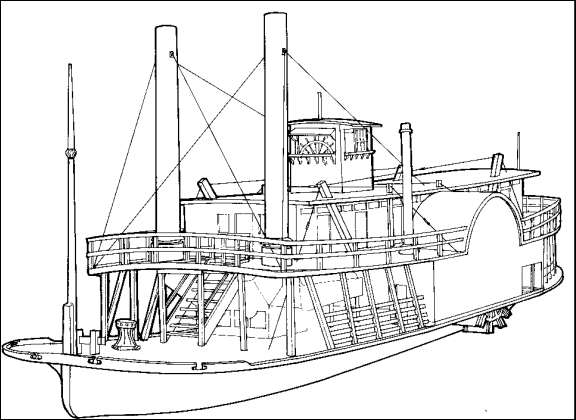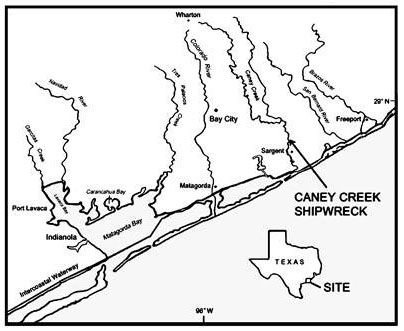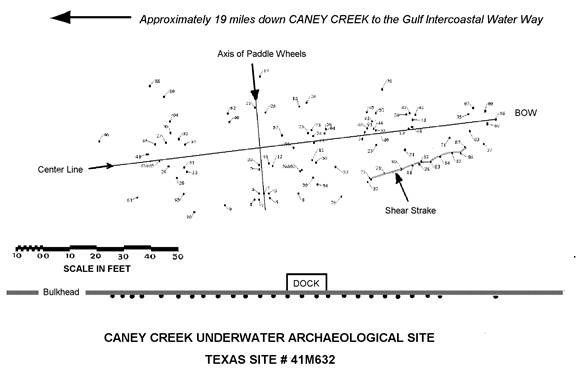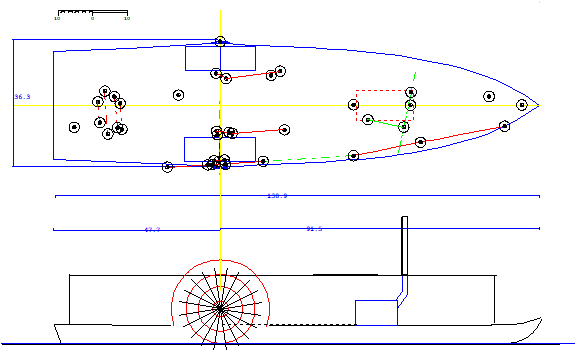The Southwest Underwater Archaeological Society
An Archaeologist’s Perspective

Introduction
One of the least understood historic preservation resources nationally consists of the shipwrecks that litter the floor of our nation’s offshore waters, harbors, estuaries, rivers, and lakes. The status of our knowledge of Texas’ shipwrecks is not an exception to this rule, although important steps toward a better understanding of these resources have come forward over the past few years. With over two thousand shipwrecks in the waters of Texas, it is impossible to evaluate them all. For one reason or another, the wrecks that might qualify for the National Register of Historic places lie threatened on the seafloor.
The underwater archaeology program of the Texas Historical Commission (THC), headed by State Marine Archaeologist, pays close attention to its obligation to protect our submerged resources. This organization puts out publications, museum exhibits, documentary films, and slide lectures, and encourages press coverage that brings the agency’s work to the public to enhance the public’s appreciation of the past. These efforts help build support for historic preservation within the state and between the people of Texas and the cultural resources that exist within state boundaries.
Several factors contribute to the necessity of adding public participation to the list of support essential to the THC. Consistent budget cutbacks in the last decade hamper the THC’s ability to conduct field studies on shipwreck sites, and a new obligation came forward in the late 1980s with the Abandoned Shipwreck Act of 1987. This Act gives the state title to historic shipwrecks in its waters. The legislation and the associated federal guidelines specify that states should have active cultural resource management programs and research programs for shipwrecks. These guidelines also specify that the states should provide appropriate private sector access to shipwrecks (1).
The current situation requires that the THC do more with less, which is similar to the idea of reinventing government (2). The State Marine Archaeologist is actively incorporating partnerships with other government agencies to increase the effectiveness of its shipwreck program. Along with these agencies, the State Marine Archaeologist also gets assistance from the public sector. One of the most disputed and possibly least understood resources available to state archaeological programs is the availability of volunteer sports divers.
The Southwest Underwater Archaeological Society
Incorporating volunteers into archaeological projects can go a long way toward helping an agency fulfill its obligations under the Abandoned Shipwreck Act. This process does not require any additional funds to function and it gives a project the advantage of additional resources. With the cutbacks in all areas of government spending, archaeologists are having to put more and more volunteers into the field. This has led many to question the validity of the undertaking (3). This is especially true in the field of Nautical Archaeology, where the adage still echoes, “It is easier to teach an archaeologist how to dive than it is to teach a diver to be an archaeologist (4). The truth of this statement is apparent, but it does not prohibit the use of sports divers on underwater archaeological projects. These men and women can use the lessons learned in other areas of diving. The Southwest Underwater Archaeological Society organizes its members with just such an idea in mind.
In response to providing a diving activity for sports divers at a local level, the South-West Regional representative for US Divers, Inc., approached the State Marine Archaeologist of Texas with an idea to help the State of Texas with shipwreck surveys. Of the 2000 shipwrecks in Texas’ waters, two-thirds are available for all kinds of private sector access (5). The objective presented to the State was to offer aid by allowing volunteer sports divers to participate in shipwreck projects. Shortly afterward the Southwest Underwater Archaeological Society (SUAS) was formed.
The membership of the SUAS originally came from the experienced dive community well known to the founder of the states in which he did business. These men and women were either dive masters or instructors, but the membership grew to include those from other disciplines who brought different skills to the SUAS. Also, many professionally trained archaeologists donated their time to help evaluate the shipwrecks and give insight to the sports diving community about the issues of archaeology and the methodology used to examine a site underwater.
Emphasizing the non-collecting and non-excavating aspect of mapping the exposed portions of a wreck, the SUAS required that all participants sign an ethics statement respecting the tenets of the THC. Each participant must also attend a training session before being allowed to participate in any archaeological survey. These training sessions helped give SUAS members a better understanding of historical archaeology, underwater wreck sites in Texas, and the role of the THC. Reviewed are instructions on various archaeological methods used for determining the nature and extents of the wreckage. These techniques are then put into practice in a pool. Since conditions in the waters of Texas are greatly different from a pool, duplication of field conditions is an important part of the training. Supervisors black-out masks to give the impression of black-water diving. Objects placed at the bottom of the pool represent artifacts or ship’s timbers. Divers blindly feel these objects to get a better understanding of the conditions they will face on a site. This method helps members strengthen their verbal descriptions and drawing skills as they reproduce the objects from the pool.
Caney Creek Steamboat Wreck (Site 41MG32)
To test the organization's ability to accurately survey shipwrecks, the State Marine Archaeologist chose a steamboat wreck in an inland river in Matagorda County, Texas. Near the east end of Matagorda Bay, about 14 miles above the mouth of Caney Creek, lies a locally known, yet unidentified, steamboat wreck (Figure 1).

Designated archaeological site 41MG32, the sidewheeler dates to the 19th century, possibly the Civil War period. Investigation of the wreck took place twice in the 1980’s, once by students from the Nautical Archaeology Program and the other by the Texas Antiquities Committee. Neither group was able to determine the identity of the wreck. The Caney Creek Steamboat Project became the first joint mapping and survey project between the THC and the SUAS.
For this project, the THC continued to foster public-private partnerships in managing shipwrecks and sought support from the professional community as well. Professional archaeologist contributed time and equipment including boats for magnetometer surveys, GPS equipment, and expertise in identifying various vessel elements encounter by divers. Graduate and undergraduate archaeology students from the University of Texas at Austin and Texas A&M University also assisted.
Support and interaction from the local community brought visits from the local press. Other local organizations that assisted were the county historical society and the local museum. Many local informants came forward to offer their help and suggestions to the identity of the vessel. This interaction between the State of Texas and the local community is an important factor in the existence of the SUAS and their involvement with underwater archaeology. This intercourse along with the activities of the sports divers on the wreck, help fulfill requirements of the THC regarding the private-public involvement that helps satisfy federal guidelines watching over all shipwreck projects in the State.
More than 2,000 volunteer hours were donated to the project by 40 divers and professional archaeologists. All volunteers provided their equipment and transportation. They also covered their hotel and meal expenses for themselves and the supervising archaeologists. Upon reaching the site, divers had many responsibilities before the dive could begin. These men and women came with the idea of touching history. Each participant came with a great amount of enthusiasm and a desire to see a piece of history in a manner that few will ever have the chance to experience.
FINDINGS
Ten field sessions were held, each about two days long. More than 120 points were plotted defining the wooden-hulled side wheeler’s layout and the scatter of remains. The vessel lies in 12 to 18 feet of water. Dive teams explored the site manually under extremely bad conditions. Using trilateration, the divers recorded the features of the vessel with the use of tape measures. For each pair of divers, there was a two-person team on shore. This procedure helped set up a baseline to orient the remains (Figure 2). The results provided a site plan that helps to illustrate the wreck as it lies in the creek (Figure 2 & 3).

Technical assistance came from the use of a Side-Scan Sonar, a Simrad Mesotech Radar and a Proton Magnetometer. The sonar and magnetometer helped identify the boundary of the wreckage, while the radar helped guide divers around the site in zero visibility water. With the help of surface-to-diver radio, the Mesotech also served to acquire information by giving the topside crew the ability to guide divers and communicate the needs of the survey. Findings indicate that the steamboat lies in the channel with its bow pointing upstream in a northerly direction listing 13º to the port side. The bow retains most of its length, but the stern only retains its shape at the port corner; the starboard portion has broken off and the remains lie scattered. No remains of the superstructure have been found to give any outward physical appearance of the steamboat.

On the first weekend trip, the above information gave archaeologists the data to contradict previous reports of the wreck. In May of 1980, an archaeologist from the Underwater Archaeological Research Section of the Texas Antiquities Committee surveyed the vessel. The archaeologist’s findings indicated that the steamboat was oriented east-west across the channel. He further reported that this wreck was from 70 to 80 feet long and represented a sternwheeler (6). In only one weekend trip, the SUAS was able to determine that this wreck was close to 140 feet long, oriented north-south and identified it as a side-wheel steamboat. The usefulness of the volunteer society demonstrated its potential the first time in the field. The most important fact about this organization is that it cost the State of Texas nothing.
The benefits of a volunteer group assisting the State of Texas in underwater archaeological surveys are coupled with the utilization of untrained volunteers. Using the project in Caney Creek as the example, one problem that concerns all archaeologist is provenience. Bringing the idea of provenience to sports divers is a task that is very important to SUAS archaeologists. In the conditions found in the waters of Texas archaeological work is hard to relate to those who are not familiar with different archaeological methods. Keeping the provenience of artifacts and ship remains in black-water in an extremely hard task to accomplish. When a sports diver first works on underwater projects they tend to disturb objects. This is not an act out of malice, but out of curiosity. As divers encounter objects, their first impulse is to bring the material to the surface to identify it. This is especially true when dealing with very shallow water. They do not yet understand the importance of keeping the remains in situ.
Talking to the divers, made SUAS archaeologists understand that most sports divers relate collecting artifacts with archaeology. Unfortunately, due to construction, pollution, erosion, and other human-caused calamities studying a site without removing a single item is not always possible. Archaeologists remove specific artifacts to answer specific research questions and for future research. Archaeologists are not out to collect artifacts, only information to share with other researchers and members of the public.
Through the work of the SUAS and the THC, the sports diving community is being informed about the methods of archaeology. This has not only been beneficial to the field of archaeology, but also to the community of sports divers. Recently, a group of divers related their experiences about archaeology and its relationship to the sport of diving. Most of the men and women who participate on SUAS projects believed that a diver who finds an artifact on a wreck was not harming the wreck or an investigation if they picked up the artifact and removed it from the site. One member of the SUAS related, “While diving on a wreck in the Virgin Islands, I found a small a small artifact. This was something that I kept. I did not harm the sight, nor did I remove anything that I thought was important. At the time, I did not think what I did was wrong. I only wanted a small souvenir (7).” Asked this question after several trips to SUAS projects, the men and women understand the importance of keeping a site intact. These members understand that every piece that remains of a site helps the archaeologists’ record and possibly identify the wreck.
Other organizations that use volunteer divers on archaeological sites understand the problems that face the SUAS. These groups are facing the same problems when dealing with sports divers in the realm of archaeology. Just as the SUAS is having successes so are other organizations. Their divers are beginning to understand the importance of archaeology in the area of underwater remains (8). The Nautical Archaeology Society and the Maritime Archaeological and Historical Society are two organizations that are very similar to the SUAS. These organizations teach archaeological methods to the sports diving community in hopes of using these trained divers on archaeological projects. Along with the efforts of teaching this information to sports divers, MAHS solicits advice from the professional world of Nautical Archaeology by having several members of highly reputable institutions as part of their organization as advisors (9). The SUAS is also instigating the involvement of sports divers in other areas of archaeology including conservation. With the help of trained conservators, SUAS members learn field conservation techniques that can be used to stabilize artifacts after removal from their underwater environment. This gives an added dimension to the role of archaeology and the position of the archaeologist.
Conclusion
In the field of Nautical Archaeology, there are many resources that help to gather information about a site. It is the job of all archaeologists to gather as much information about a site as possible to be able to draw any conclusions. There have always been problems with pot hunter, collector, scavengers, salvager and especially treasure hunters. Most people who unknowingly pick up artifacts do not mean any destruction when they remove the material from its original position. This action occurs out of a curiosity to know more about the object. Unfortunately, this curiosity is also causing the most destruction of the sites. Little by little archaeological sites are pillaged until there is nothing left for the archaeologist to examine.
The efforts of the SUAS and other similar groups try to demonstrate the importance of gathering information as opposed to removing pieces of a site. The organization is trying to illustrate to others the significance of leaving a site intact. Further responsibility given to some members of the SUAS includes directing an archaeological survey. With the involvement of the THC, approved members can direct archaeological surveys. This aspect further demonstrates the responsibilities of the archaeologist when conducting a project. It also helps members understand what is involved in setting up a project and what information needs archaeologist use to record the wreck. These members must gather all information to fulfill the criteria designated by the THC. All directors must have a project archaeologist and a dive supervisor on staff to meet the guidelines of the THC. Again, this is one more way in which the SUAS along with the THC guide the sports diving community into the realm of Nautical Archaeology.
References
- United States Government, 1990, “Abandoned Shipwreck Act; Final Guidelines; Notice” in The Federal Register, Vol. 55, No. 233, Department of the Interior, National Park Service, Washington D.C.
- Osborne, D. & T. Gaebler, 1992, Reinventing Government: How the Entrepreneurial Spirit is Transforming the Public Sector, New York.
- Hocker, Fred, 1994, Personal Communication
- George Bass, Personal Communication
- Arnold, Barto, 1992, “Texas Shipwrecks: a Statistical Characterization” in Underwater Archaeology Proceedings from the Society for Historical Archaeology Conference, Tucson, Arizona, p. 111-131.
- Boggs, Wayne, 1980, Report of the Preliminary Investigation of a Reported Shipwreck in Caney Creek, Austin.
- Rick Russell, personal communication, 1994
- Heavin, Scott, 1993, “Archaeology versus Collecting: A Diver’s Perspective,” in The Goody Bag, Newsletter of the South Carolina State Underwater Archaeological Program, Vol. 4, No. 2.
- Montgomery, G., 1994, The Maritime Archaeological and Historical Society News, Washington D.C.
Enjoying my content? Please help support my efforts by resteeming.
Thanks So Much - Liquidtravel
You received a 10.0% upvote since you are not yet a member of geopolis and wrote in the category of "history".
To read more about us and what we do, click here.
https://steemit.com/geopolis/@geopolis/geopolis-the-community-for-global-sciences-update-4
Downvoting a post can decrease pending rewards and make it less visible. Common reasons:
Submit
There are more and more underwater archaeologists, and shipwrecks are being discovered more and more, I my self am an amateur archaeologist and would love to search the "deep blue" for shipwrecks.
A very nice post, well written. :)
Downvoting a post can decrease pending rewards and make it less visible. Common reasons:
Submit
Thank you very much. I appreciate your comment.
Downvoting a post can decrease pending rewards and make it less visible. Common reasons:
Submit
First time I resteemed a post :-) Keep these posts coming. I really enjoy reading these as a hobby diver.
This also relates a bit to Belgium because we also have a lot of wrecks laying before our coast. The biggest problem here about investigation is the fact the a large part of the North Sea is reserved for shipping traffic and that the this part of the North Sea is one of the busiest in the world.
Downvoting a post can decrease pending rewards and make it less visible. Common reasons:
Submit
Thank you very much. I really appreciate your continued support. Really appreciate the resteem.
Downvoting a post can decrease pending rewards and make it less visible. Common reasons:
Submit
Such a well-written and informative post. I guess I never really thought about how many shipwrecks there are on the Texas coastline, and the entire Gulf I would imagine. Very interesting read.
Downvoting a post can decrease pending rewards and make it less visible. Common reasons:
Submit
Thanks. I appreciate it. There are wrecks along the coast, in the Gulf, and in many rivers throughout Texas.
Downvoting a post can decrease pending rewards and make it less visible. Common reasons:
Submit
Congratulations, Your Post Has Been Added To The Steemit Worldmap!
Author link: http://steemitworldmap.com?author=liquidtravel
Post link: http://steemitworldmap.com?post=underwater-archaeology-and-the-public-sports-divers-to-the-rescue
Want to have your post on the map too?
Downvoting a post can decrease pending rewards and make it less visible. Common reasons:
Submit
Weldone on a well researched material. I like how your reference was written
Downvoting a post can decrease pending rewards and make it less visible. Common reasons:
Submit
A really nice and informative piece. Thankyou for sharing, also i see "vincentb" Tag. Lets upvote one another
Downvoting a post can decrease pending rewards and make it less visible. Common reasons:
Submit
Your Post Has Been Featured on @Resteemable!
Feature any Steemit post using resteemit.com!
How It Works:
1. Take Any Steemit URL
2. Erase
https://3. Type
reGet Featured Instantly � Featured Posts are voted every 2.4hrs
Join the Curation Team Here | Vote Resteemable for Witness
Downvoting a post can decrease pending rewards and make it less visible. Common reasons:
Submit